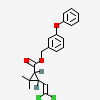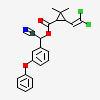Anopheles gambiae
Anopheles gambiae is one of the most important vectors of malaria in sub-Saharan Africa. This mosquito species is highly adapted to breeding in human-modified environments, such as temporary pools and artificial containers. It is known for its role in transmitting Plasmodium parasites that cause malaria, making it a significant target for malaria control programs. Strategies to manage A. gambiae populations include the use of insecticide-treated nets, indoor residual spraying, and larvicidal treatments to reduce mosquito breeding sites.
From Wikipedia
NCBI Taxonomy ID: 7165
12 pairs of Verified P450 and Compounds
| Gene Symbol | Compound | Validation | Reference |
|---|---|---|---|
| CYP6M2 | E | ||
| CYP6M2 | X | ||
| CYP6M2 | E | ||
| CYP6M2 | E | ||
| CYP6P3 | E | ||
| CYP6P4 | E | ||
| CYP6P5 | E | ||
| CYP6Z2 | E | ||
| CYP6Z2 | E | ||
| CYP6Z2 | E | ||
| CYP9J5 | E | ||
| CYP6P2 | E |




